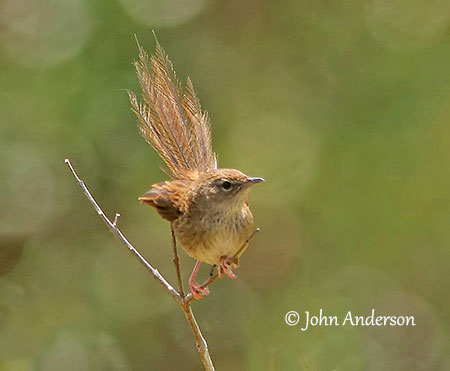
RANGE:
The Grey Emu-tail is found in the mountains of E Madagascar.
HABITAT:
The Grey Emu-tail frequents freshwater marshes bordering the rainforest or within it. These swampy areas usually have dense aquatic vegetation including rushes, herbs, heath or grassland. It may occur in abandoned ricefields reverted to swampy grass or sedge.
This species is usually visible between 1,800 and 2,600 metres of elevation, but probably lower after the breeding season, around 900 metres.
CALLS AND SONGS: SOUNDS BY XENO-CANTO
The Grey Emu-tail’s call is a low, grating “chip…chip” quiet and inconspicuous. The song is a complex duet including low “chip chip chip chip chipgrr” followed by high, warbling trill “pipipipipi” and then, by a slightly lower and slower trill “twewewewewe”. This duet finishes with low, chipping sounds given by one of the birds. Frequently, only the two first elements can be heard.
BEHAVIOUR IN THE WILD:
The Grey Emu-tail feeds on tiny insects. It remains hidden in the low vegetation and clambers among grass stalks.
It is usually solitary, apart from family groups. However, it can be seen in the early morning, perched up in the open to avoid the wet grass. Its presence is often revealed by bursts of songs.
The breeding season is related to prey abundance for raising the chicks.
The Grey Emu-tail is resident on the island, but it probably reaches lower elevations after breeding.
The flight appears heavy and laboured with long dropping tail. It may sometimes fly 3-4 metres above the vegetation before dropping in after a few metres. While descending, it moves quickly through the tangled vegetation.
REPRODUCTION OF THIS SPECIES:
The breeding behaviour of the Grey Emu-tail is poorly known. From some observations, only two nests are described.
The structure is a deep bowl made with coarse grasses and lined with softer grasses. This untidy structure is bulky. The nest was placed in dense clump of grasses or sedges and close to the marsh.
One of the observed nests was built less than one metre above water. The other nest had a fairly long escape tunnel leading from the nest through the grassy vegetation.
The female lays at least two eggs, as two young were found in each nest. The breeding season probably occurs in August-September to November, based on the observation of adults in breeding conditions and of a recently fledged juvenile. Both adults share the nesting duties.
PROTECTION / THREATS / STATUS:
The Grey Emu-tail has restricted range in E Madagascar. It is uncommon but probably overlooked due to its secretive habits. It appears to be widespread in suitable humid habitats, and the species is not globally threatened.
It is currently evaluated as Least Concern.
Fr: Amphilaïs tachetée
Ang: Grey Emu-tail
All: Madagaskargrassänger
Esp: Yerbera Malgache
Ita: Emuro grigio
Nd: Madagaskargrasvogel
Sd: madagaskargräsfågel
Mal: Serika, Tanimbary
Photographer:
John Anderson
John Anderson Photo Galleries
Text by Nicole Bouglouan
Sources :
HANDBOOK OF THE BIRDS OF THE WORLD Vol 11 by Josep del Hoyo, Andrew Elliott and David Christie - Lynx Edicions - ISBN: 849655306X
Birds of Madagascar and the Indian Ocean Islands Par Roger Safford, Adrian Skerrett, Frank Hawkins – ISBN: 1472924118, 9781472924117- Editeur: Bloomsbury Publishing, 2015
The Birds of Africa: Volume VIII: The Malagasy Region: Madagascar, Seychelles, Comoros, Mascarenes - Par Roger Safford, Frank Hawkins – ISBN: 1408190494, 9781408190494- Editeur: A&C Black, 2013
Bird families of the World - GRASSBIRDS Locustellidae – Don Roberson
Wikipedia, the free encyclopaedia
Grey Emu-tail
Amphilais seebohmi
Passeriformes Order – Locustellidae Family
INTRODUCTION:
The Grey Emu-tail or Madagascar Grassbird is endemic to Madagascar. It is placed in the subfamily Megalurinae, in the large family Sylviidae that gathers the Old World warblers. It was formerly placed in the genus Dromaeocercus, alongside the Brown Emu-tail, because of similarities in tail structure. The Grey Emu-tail is the sole member of the genus Amphilais. Its scientific name pays tribute to the English ornithologist Henry Seebohm.
It frequents marshy vegetation and swampy areas in rainforest clearings, usually at high elevations, between 1,800 and 2,600 metres, sometimes lower. It feeds on small insects and is usually seen alone.
The Grey Emu-tail is widespread and locally common in Madagascar, but it is restricted to marshy and swampy areas in E Madagascar.
DESCRIPTION OF THE BIRD:
Biometrics:
Length: 17 cm
Weight: 20 g
The Grey Emu-tail has grey-brown head and upperparts, with warm brown wash on uppertail-coverts. Crown, nape and upperparts are conspicuously streaked with balck feather centres. The flight feathers are dark brown with paler edges. The long, graduated tail is brownish with fragile appearance due to prominent rachis and spaced barbs.
On the underparts, throat and breast are buffy-white with brown streaks. Flanks and belly are mostly olive-brown. Axillaries and underwing-coverts are buffy-white.
On the grey-brown head, we can see a buffish supercilium. Lores, ear-coverts, cheeks and neck sides are ochreous-brown.
The two-tone bill has blackish upper mandible and greyish-horn lower mandible. The eyes are dark brown with white crescent below the eye. Legs and feet are flesh-pink.
Male and female are similar.
The juvenile resembles adult, with yellowish wash on the underparts.
